E.max Veneers vs Porcelain Veneers: A Clinical Perspective for Dentists
Dentists and patients alike often encounter the phrase “E.max veneers vs porcelain veneers”. At first glance, this comparison can be misleading. Technically, E.max is a type of porcelain veneer. However, because of its strong brand recognition and distinct material properties, E.max is frequently discussed as if it were a separate category. This article aims to clarify the differences, highlight the unique characteristics of E.max veneers, and help dentists choose the most suitable restorative option for each clinical situation.
Porcelain Veneers – An Overview
Porcelain veneers are thin ceramic shells bonded to the labial surface of anterior teeth. Their primary purpose is to improve dental esthetics, restore form and function, and preserve as much natural tooth structure as possible. Since their introduction in cosmetic dentistry, veneers have become a cornerstone of minimally invasive restorative procedures.
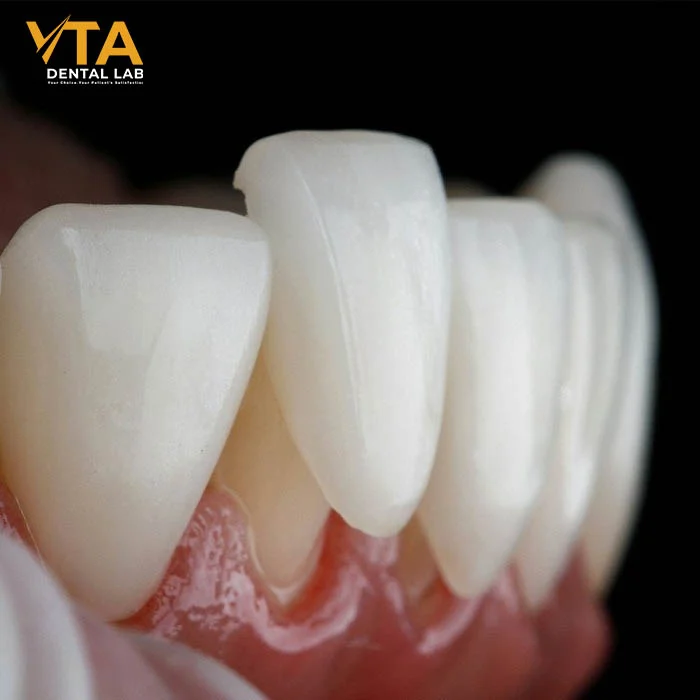
Close-up of porcelain veneer edges showing natural layering
Porcelain veneers can be broadly divided into several categories, each with unique strengths and limitations:
- Feldspathic veneers: These are the most traditional form of porcelain veneers, fabricated from feldspathic porcelain through layering techniques. They are renowned for their superior translucency and ability to mimic natural enamel. Their main drawback is relatively low flexural strength (approximately 100 MPa), which makes them more prone to chipping or fracture under high occlusal load. They are often chosen for cases that prioritize aesthetics over strength.
- E.max veneers (Lithium disilicate): These veneers are crafted from lithium disilicate glass-ceramic, offering a balance of mechanical durability and optical beauty. With flexural strength in the 360–400 MPa range, they are substantially stronger than feldspathic porcelain while still maintaining high translucency. This material is suitable for a wide range of clinical cases and has become one of the most commonly prescribed veneers in modern dentistry.
- Zirconia veneers: Zirconium dioxide-based ceramics are known for their exceptional strength (900 – 1100 MPa), making them an excellent choice for patients with bruxism or high occlusal forces. However, zirconia is generally more opaque than feldspathic or lithium disilicate ceramics, limiting its use in highly esthetic anterior cases unless modified with porcelain layering.
In essence, porcelain veneers represent a spectrum, from the ultra-esthetic but fragile feldspathic to the ultra-durable but less lifelike zirconia, with lithium disilicate (E.max) positioned as the middle ground.
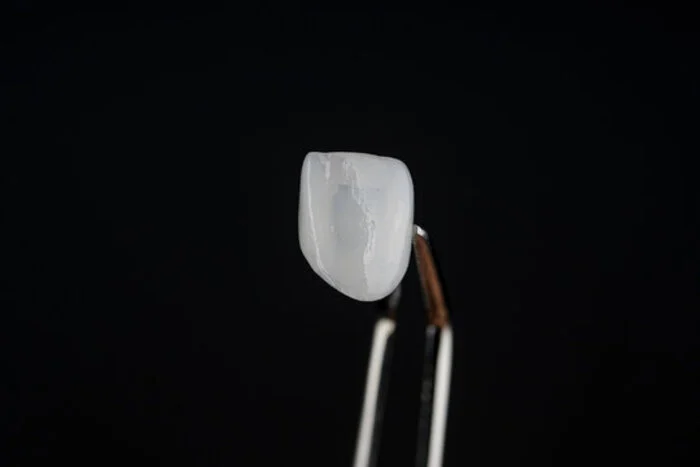
Side-by-side translucency test of E.max veneers vs porcelain veneers materials
E.max Veneers – Key Characteristics
E.max, developed by Ivoclar Vivadent, has become almost synonymous with modern veneer dentistry due to its predictable clinical outcomes. Below are its defining characteristics:
Material composition:
E.max veneers are made from lithium disilicate glass-ceramic, a material specifically engineered to balance strength and esthetics. The crystalline structure accounts for approximately 70% of the material’s composition, providing mechanical reinforcement without compromising translucency.
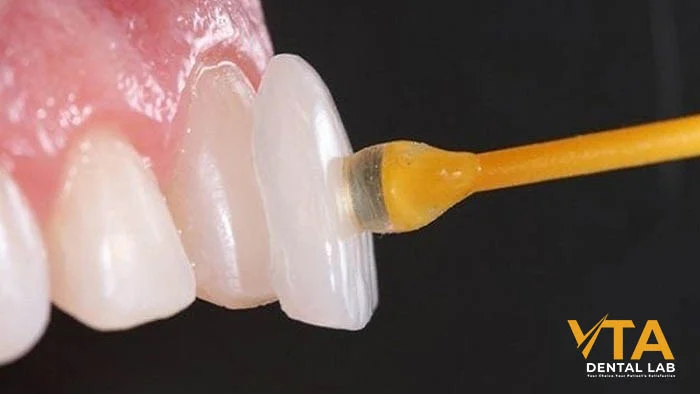
A dentist is placing E.max veneers on the patient’s upper front teeth
Mechanical properties:
- Flexural strength: 360–400 MPa, significantly stronger than feldspathic porcelain but less than zirconia.
- Fracture toughness: Adequate for anterior teeth under normal occlusal forces.
- Longevity: Clinical studies have reported survival rates of over 90% at 10 years, when proper case selection and bonding techniques are followed.
Optical properties:
- High translucency: Mimics the light transmission of natural enamel.
- Shade versatility: Available in multiple ingot opacities (HT – High Translucency, LT – Low Translucency, MO – Medium Opacity, HO – High Opacity) to address different underlying tooth shades.
- Fluorescence and opalescence closely resemble natural teeth, providing a lifelike result even in challenging esthetic zones.
Preparation requirements:
- Conservative tooth preparation: 0.3–0.7 mm reduction, allowing for minimally invasive approaches.
- Can be fabricated as ultra-thin veneers in selected cases, reducing the need for aggressive enamel removal.
- Requires adhesive bonding protocols to maximize strength and prevent debonding.
Limitations:
- Highly dependent on correct bonding: The veneer must be etched and bonded using resin cement to ensure long-term stability.
- Contraindicated in patients with severe bruxism, edge-to-edge occlusion, or very dark underlying tooth structure (where opacity may not be sufficient).
More expensive than conventional feldspathic porcelain, which may influence patient acceptance in cost-sensitive markets.
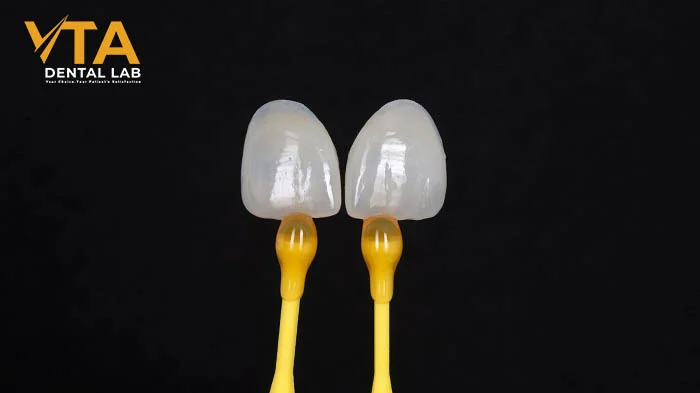
CAD/CAM digital design of E.max veneers before milling process
E.max veneers have become a preferred choice because they offer the best compromise between esthetics and durability. They are versatile enough to handle most anterior restorative cases and are supported by robust clinical evidence.
Comparative Analysis: E.max Veneers vs Porcelain Veneers
| Criteria | E.max Veneers | Feldspathic Veneers | Zirconia Veneers |
| Esthetics | High – excellent translucency and shade matching | Very high – gold standard for natural esthetics | Moderate – more opaque, less lifelike |
| Strength | 360–400 MPa (reliable for most cases) | ~100 MPa – fragile under stress | >800 MPa – extremely durable |
| Tooth prep | Minimal (0.3–0.7 mm) | Very minimal, but fragile | Often requires more reduction |
| Indications | Anterior restorations, cases needing a balance of strength and esthetics | Elite esthetics, minimal prep, but limited durability | Bruxism, high-stress occlusion, and posterior restorations |
Clinical Considerations – When to Choose E.max
Choosing the appropriate veneer material requires careful evaluation of the patient’s clinical condition, esthetic goals, and functional requirements. Below are some guidelines:
E.max veneers:
- Indicated for most anterior restorations where both esthetics and strength are required.
- Particularly effective for patients seeking a natural smile makeover with reliable long-term outcomes.
- Ideal in cases of diastema closure, tooth reshaping, and moderate discoloration (when combined with proper ingot opacity).
- Offers versatility in thickness and shade selection, making it a go-to option for everyday esthetic cases.
Feldspathic veneers:
- Best suited for cases that demand ultra-high esthetics with detailed characterisation.
- Suitable for patients with low occlusal stress and sufficient enamel substrate for bonding.
- Often selected for “Hollywood smile” makeovers, where the emphasis is on visual perfection and minimal tooth reduction.
- Not recommended for patients with functional risk factors like heavy bite or parafunctional habits.
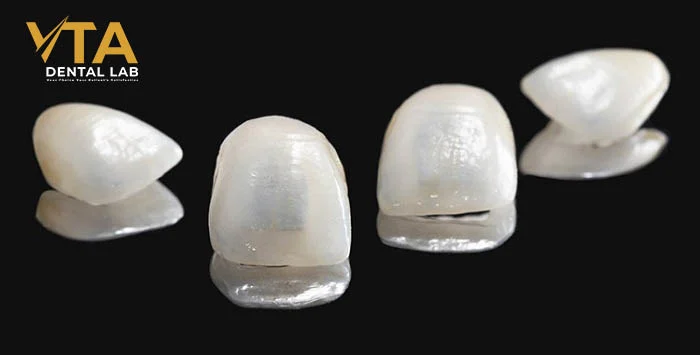
Feldspathic veneers
Zirconia veneers:
- Indicated in cases of high functional demand, such as patients with bruxism, clenching, or significant parafunctional activity.
- A good option when masking severely discolored teeth where higher opacity is required.
- More durable in posterior restorations or cases where esthetics can be slightly compromised for longevity.
- Require careful planning to ensure acceptable esthetic outcomes despite lower translucency.
Ultimately, the selection process should combine clinical judgment, patient expectations, and laboratory collaboration. Dentists should also consider digital smile design tools and mock-ups to align with patient expectations before final restoration.
Conclusion
E.max veneers represent a balanced solution within the porcelain veneer family, combining natural esthetics with adequate strength for most anterior cases. While feldspathic veneers still dominate in terms of unmatched translucency, and zirconia excels in mechanical performance, E.max provides a dependable middle ground.
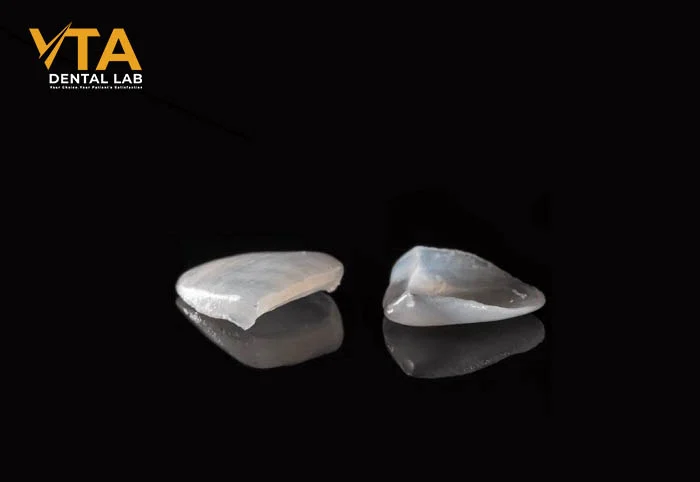
E.max veneer shells showing natural translucency and thin profile
At VTA Dental Lab, we work closely with dentists to ensure the right material is chosen for the right case. Our expertise in handling E.max, feldspathic, and zirconia veneers allows us to deliver restorations that balance esthetics, function, and longevity. By partnering with a trusted laboratory, dentists can enhance treatment predictability and patient satisfaction.
For dentists, the decision should be guided by case selection, patient expectations, occlusal assessment, and collaboration with a skilled dental laboratory. Ultimately, no single material is universally superior—the best outcome comes from matching the right veneer type to the right patient.
FAQs
Are E.max veneers better than porcelain veneers?
E.max veneers are a type of porcelain veneer. They are not universally “better,” but they often offer the best balance between strength and esthetics.
What is the main difference between E.max and porcelain veneers?
The term “porcelain veneers” is broad. E.max specifically refers to lithium disilicate veneers, which are stronger than feldspathic porcelain and more esthetic than zirconia.
When should I avoid E.max veneers?
Avoid in cases with severe bruxism, heavy occlusion, or when ultra-high durability (e.g., zirconia) is required.